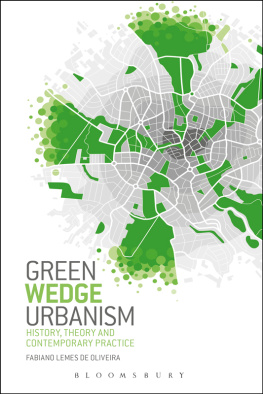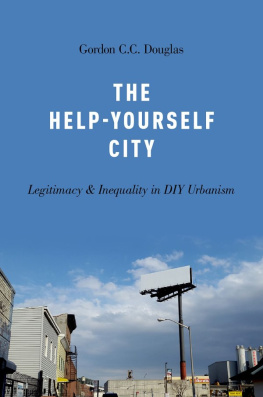SUSTAINABLE
URBANISM
Copyright 2008 by Farr Associates.
All rights reserved
Published by John Wiley & Sons, Inc.,
Hoboken, New Jersey
Published simultaneously in Canada
No part of this publication may be reproduced, stored in a retrieval system, or transmitted in any form or by any means, electronic, mechanical, photocopying, recording, scanning, or otherwise, except as permitted under Section 107 or 108 of the 1976 United States Copyright Act, without either the prior written permission of the Publisher, or authorization through payment of the appropriate per-copy fee to the Copyright Clearance Center, 222 Rosewood Drive, Danvers, MA 01923, (978) 750-8400, fax (978) 646-8600, or on the web at www.copyright.com . Requests to the Publisher for permission should be addressed to the Permissions Department, John Wiley & Sons, Inc., 111 River Street, Hoboken, NJ 07030, (201) 748-6011, fax (201) 748-6008.
Limit of Liability/Disclaimer of Warranty: While the publisher and the author have used their best efforts in preparing this book, they make no representations or warranties with respect to the accuracy or completeness of the contents of this book and specifically disclaim any implied warranties of merchantability or fitness for a particular purpose. No warranty may be created or extended by sales representatives or written sales materials. The advice and strategies contained herein may not be suitable for your situation. You should consult with a professional where appropriate. Neither the publisher nor the author shall be liable for any loss of profit or any other commercial damages, including but not limited to special, incidental, consequential, or other damages.
For general information about our other products and services, please contact our Customer Care Department within the United States at (800) 762-2974, outside the United States at (317) 572-3993 or fax (317) 572-4002.
Wiley also publishes its books in a variety of electronic formats. Some content that appears in print may not be available in electronic books. For more information about Wiley products, visit our web site at www.wiley.com .
Graphic Design (interior); Sam Silvio,
Silvio Design Inc.,Chicago
Wiley Bicentennial Logo:
Richard J. Pacifico
Library of Congress
Cataloging-in-Publication Data:
Farr, Douglas
Sustainable urbanism: urban design with nature/Douglas Farr.
p. cm.
Includes bibliographical references and index.
ISBN 978-0-471-77751-9 (cloth)
1. Urban ecology. 2. Urban ecology United States. 3. City planning Environmental aspects. 4. Sustainable development. 5. Neighborhoods.
I. Title. HT241.S8736 2008
307.76dc22
2007029064
To Gail, Will, my inspiring
colleagues at Farr Associates, and
the good Kingdom of Upnot
Foreword
The time has come, the Walrus said,
To talk of many things:
Of shoesand shipsand sealing-wax
Of cabbagesand kings
And why the sea is boiling hot
And whether pigs have wings.
Lewis Carroll (1872)
Through the Looking-Glass
And so indeed, the time has come. This was the year when the Intergovernmental Panel on Climate Changes report converged with An Inconvenient Truth. The boundaries of our playing field are now visible. The vast and amusing game called the American Lifestyle has limits after all!
What shall we do now?
Well, with about forty years worth of dedicated publications, there is certainly a lot of know-how available. For example, on my offices green bookshelf, the 1963 edition of Olgyays Design with Climate sits 3 feet away from last years edition of Schaeffers Solar Living Sourcebook . My collection may be impressivebut I am not its equal. When I count which ones of these many books I have managed to really study, the honest answer is just one: Christopher Alexanders A Pattern Language .
Surely, this cannot be entirely my fault, for I am known to be a disciplined and interested reader.
The problem may lie with the books themselves. It seems that when I try to read the hortatory ones, I get their point well before the last page; and the technical ones are just too tedious to get through. Besides, both of these kinds of books are usually too specialized, with each author implying that their particular silver bullet is the important one to deal with the worlds environmental problem.
And so it has been for decades: waves of books asserting the importance of safeguarding habitat; or the danger of atmospheric pollution; or the demise of water quality; or the dreaded holes in the ozone layer; or the need for conservation, recycling or alternate energy; or the urgency of reinstating the production of local, organic agriculture; or green building. Taken together these books offers a complete body of knowledge, but no single volume has been holistic (or legible) enough to induce my expertisewith the unique exception of A Pattern Language .
Why then, having Alexanders book already in hand, should we welcome Doug Farrs? It may be, ironically enough, because A Pattern Language is too beautiful; too much a work of art. It is an epic, worthy of being the foundation myth of a great, ethical, intelligent, pleasurable civilizationone I would delight to inhabit. Alas, however, most Americans have come to mistrust intuition as a basis for action. Our leaders trust technique, not mystique. They require studies to provide them with metrics that support accountability. Happily, Doug Farrs manual responds well to this situation. While it is similar to Alexanders in that it propounds the full range of elements necessary for a sustainable future, it is potentially more convincing because it does so technically.
Also, like A Pattern Language , this manual designates the human settlement patternand not just the dwellingas the crucial variable in the environmental equation. This makes a great deal of difference, as the absence of the community scale in the environmental literature has been masked by the recent obsession with green buildingthe latest of the silver bullets. But this is a long story, beginning with Ian Mc Hargs early Design with Nature , which did not make a proposition regarding what was to be built once the where had been determined.
The primacy of the settlement pattern is demonstrated by what can happen when it is overlooked: Take the ecologically-sited headquarters to which every employee must daily drive a long distance; or the green Wal-Mart that depends on a trade area of 35 miles; or the chic model house in the desert with solar glass walls of impossible expense. With this manual, such absurdities are shown for what they are.
Without dismissing the techniques involved, Farr corrects the equation. The books presentation has a refreshing bias towards the practical and the pleasurable, and it also avoids case studies that are dependent on the sort of socialized subsidies that disqualify many marvelous European models from widespread influence in this country. No less important, he is practiced enough to avoid the imposition of austerities and inconveniences as a condition of securing a sustainable dwelling. Americans will not voluntarily tolerate suffering.
But there is nothing in this manual that recommends a neo-medieval nightmare. It may advocate a simplification, but that could lead to a more pleasant, elegant and meaningful life, and one relieved of the spiritual pall that comes from harming the planet which nurtures us.
Andrs Duany
Preface









